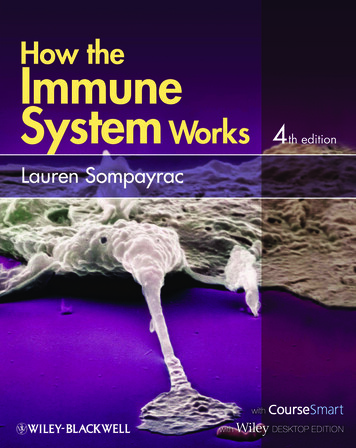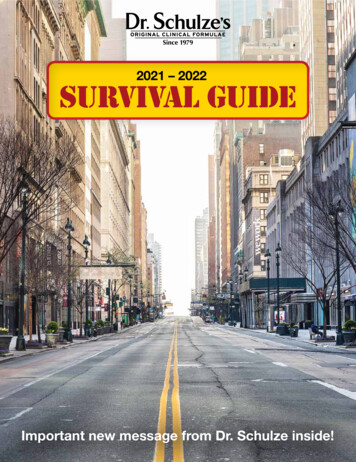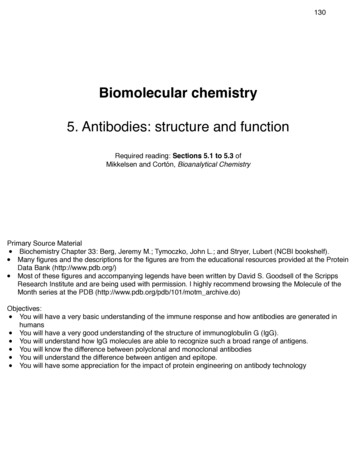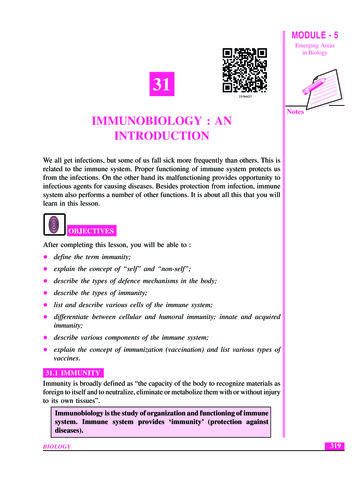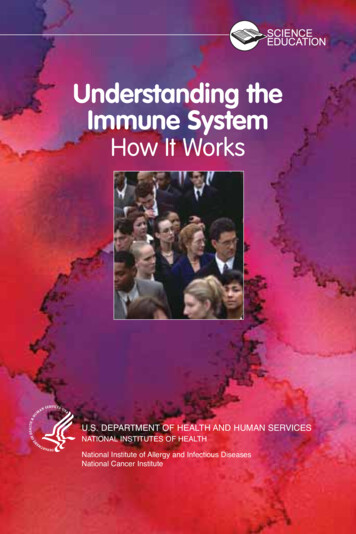
Transcription
Introduction to theImmune SystemStephen CanfieldAsst. Prof. MedicineAllergy/ImmunologyPrologue:The Immune System in HealthDefense against invading organismsSurveillance against malignancyOrchestrator of tissue repairPatrol against senescenceInterface with metabolic processesBody temperatureFe3 balanceBody mass1
Prologue:The Immune System in DiseaseToo little - immune deficiencyToo much - attack on selfToo long - tissue remodelingToo vigilent - hypersensitivityToo effective - graft rejectionPrologue:Tips on Challenges You Will FaceDetails, details, details - new vocabulary“Rules” are built on experimental observationEvery rule has an exceptionThe “system” is a network of many playersZoom in to study a player, but remember.Pan around to see how it fits in big pictureThe elegance is in the orchestra, not one playerUnderstanding is evolvingNew concepts and new players added every year2
Plight of the Hapless PathogenEpidermis,Mucous MembranesSerum,LymphInnatePre-existing Hostile MilieuPre-positioned guards ready to engulfDermalandsubmucosaltissuesAdaptiveSentries ready to sound the alarmReconnaissance specialistsReturn invader “fingerprints” to the centralimmune systemPeripheraltissuesImmune BrainUses recon data to build the perfect responderRemembers the invader for future rapid response2o LymphoidOrgans2o Lymphoid Organs:LN, SpleenMucosa-Associated LymphoidTissueInnate Immune SystemSolubleComplement CascadeCellularPhagocytesNatural KillersArray of sensors for “danger”Recognize pathogen-associated molecularpatterns (PAMP’s) - shared by many pathogensLPSCpG DNAMannoseFlagellindsRNARapid activation - no prior contact needed3
The Complement SystemThe pre-existing hostile milieuSet of 25 highly abundant serum proteinsForms a proteolytic cascade at the cell surfaceGeneration ofcell-bound fragmentsRelease ofsoluble fragmentsLysis of pathogen cellorTagging of pathogenfor phagocytosis:opsonizationRecruit phagocytesCells of the Innate SystemPhagocytesMacrophagesNeutrophils (aka: polymorphonuclear leukocytes)Dendritic CellsNatural Killers (NK) Cells4
Hematopoietic LineageMacrophagesTissue-resident sentinels& refuse collectorsArrayed with “sensors”:- PAMP receptors- Complement R’s- Antibody R’sReorganize cytoskeletonin response to these inputs:Seek & EngulfSompayrac: How the Immune System Works, 3rd Edition. Copyright 2008 by Blackwell Publishing, Inc.5
MΦ as Refuse ManagerUsed with permission, Cells Alive.comNeutrophilsMost abundant blood leukocyte- 3 million/day exit bone marrow- production with infectionExit blood tissue when calledChemotax along gradients:- pathogen components- complement fragments- macrophage signalsEngulf and killSurvive hours to days - major component of pusLichtman, et al: Review of Immunology, Copyright 2005 by Elsevier, Inc.6
Neutrophil ChemotaxisUsed with permission, Cells Alive.comMacrophage/Neutrophil KillingPhago-lysosome contentsPhagocyte Oxidase oxygen radicalsInducible NO Synthase nitric oxideAcid pHProteasesJaneway, et al: Immunobiology, 6th Edition. Copyright 2005 by Garland Science.7
Dendritic CellsPhagocyte with a dual career - reconnaissance specialistStarts out a tissue-resident sentinelConstant pinocytosis - “small bites”sampling surroundingsPathogen contact career changePicks up stakes - migrates from tissueto local lymph nodeLiterally “presents” pathogenfragments to cells of the adaptivesystemBridge between the innate andadaptive responsesLichtman, et al: Review of Immunology, Copyright 2005 by Elsevier, Inc.Soluble Intercellular SignalsCytokines - secretory proteins that mediateimmune cell development & inflammatoryreactionsBind to specific receptors on signal-receiving cellsInfluence the state of activation, effectorfunctions, or lineage of the recipient cellInterleukins - cytokines that generally function tocommunicate between leukocytesChemokines - small cytokines that function inleukocyte chemotaxis: hence “chemo-” “-kine”8
Innate Call for HelpPAMP recognition MΦ activation ALARM Secrete interleukin-1 (IL-1) Secrete tumor necrosis factor (TNF-α)Two critical “innate” immune system cytokines:Activate nearby neutrophilsAlter local vascular endothelium recruit more neutrophilsSignal DC’s to “mature” - initiate migrationSignal hypothalamus to body temperatureIs that all there is?Yes, for 99% of the animal kingdomBut if you’re a jawed vertebrate. there’s more!Adaptive Immune System: B & T LymphocytesLearn from pathogen contact: effectivenessDiscern fine molecular differences:Addition of a phosphate group to an amino acidside chain in a polypeptideThe target of these lymphocytes is termed an antigen(abbreviated Ag)9
How the Adaptive System LearnsEach cell develops with a unique Ag receptorGenerated randomlyGen. by genomic DNA rearrangementExtremely diverse: 100 billion possible R’sNaive lymphocytes patrol 2o lymphoid organsMost never find Ag survive 3 weeksLucky few: Ag encounter activation andproliferation clonal expansionB LymphocytesDevelop in the bone marrowEach new B cell makes a unique antigen receptor (BCR)This BCR is also called surface immunoglobulin (Ig),or antibodyAg binding by BCR clonal expansionSome daughter cells become plasma cells: immunoglobulinsecreting factoriesOthers become memory B cells: long-lived, capable of rapidresponse on re-encounter of antigen10
ImmunoglobulinsABinntigdin engentig ingnA indBVHTetramerVL2 H chains 2 L chainsCH1ComplementarityDeterminingRegions (CDR’s)CLInterchain disulfidesCH2Variable End - CDR’sHuge diversityCH3Constant End}Fc Region:Complement InitiationFc Receptor BindingDetermines Ig Class:IgM, IgD, IgG, IgA, IgEand effector functionsImmunoglobulin-Antigen BindingAgVHAgVHVLVL11
T LymphocytesHematopoietic origin (marrow) but most oftheir development occurs in the thymusLike B cells, T cells:Utilize a surface Ag receptor (TCR)Extreme diversity of Ag bindingAg receptor triggering is required to initiateclonal expansionAg “experienced” cells produce a long-livedmemory populationT LymphocytesUnlike B cells, T cells:Never secrete their Ag receptorCannot bind free antigen molecules - onlypeptides of 8-25 amino acidsRequire that Ag be presented to them on aspecial “billboard”:Major Histocompatibility MoleculeAbbas, et al: Basic Immunology, 3rd Edition. Copyright 2008 by Saunders, an imprint of Elsevier,Inc.12
Major Histocompatibility MoleculesTwo Classes: I and IIHighly polymorphicVary greatly from oneindividual to the nextIdentified as the basis fororgan rejection betweengenetically non-identicalindividualsAlso termed “HumanLeukocyte Antigens” (HLA)Reproduced with permission CartoonStock.comMHC Class IantigenpeptideExpression:All nucleated cellsStructure:α-chain β2 microglobulinAntigenic peptides:Derived from cell’scytoplasm (generally fromproteins made within thecell)Viral PeptidesMHC ICytoplasmNucleusAdapted from Janeway, et al: Immunobiology, 6th Edition. Copyright 2005 by Garland Science.13
MHC Class IIExpression:Antigen presenting cells(APC’s)Examples - macrophages,dendritic cells, B cellsStructureα and β chainsMHC IIAntigenic peptidesLysosomeDerived from the cell’sendocytic compartment(generally from proteinsexternal to the cell)NucleusH Adapted from Janeway, et al: Immunobiology, 6th Edition. Copyright 2005 by Garland Science.Peptide/MHC Class I14
T Cell Career PathsCD4 T cellsMost commonly termed“helper T cells” (TH’s)IFN-γTHRecognize Ag peptidepresented by MHC ClassIIProvide essentialactivation signals to BCells, CD8 T cells, andphagocytesIL-4THCytokineCD40LContactsoluble - cytokinessurface molecules - CD40LJaneway, et al: Immunobiology, 6th Edition. Copyright 2005 by Garland Science.CD40T Cell Career PathsCD8 T cellsMost commonly termed“cytotoxic T cells” (CTL’s)Recognize Ag peptidepresented by MHC Class IKill target cells expressingabnormal cytoplasmicproteinsInfected by intracellularpathogen - eg, virusTumor cellsKillingpuncture cell membraneInduce programmed celldeath or apoptosisJaneway, et al: Immunobiology, 6th Edition. Copyright 2005 by Garland Science.15
Natural Killer (NK) CellsLymphocyte without BCR or TCR - “innate”likeDon’t require prior contact or clonal expansionReceptors recognize distressed cells:Virally infectedDNA damagedTransformed (malignant)Also recognize cells opsonized by IgKill, using a mechanism similar to CTL’sInnate vs. Adaptive ImmunityInnateAdaptiveOn firstcontactImmediate response5-10 days for clonalexpansionReceptorSpecificityBroad classes ofmoleculesHighly specific for asingle structureLigandsMicrobial originPotentially anyprotein, lipid, or carboMemoryNoneLong-livedRecurrentcontactSame response aspreviouslyRapid responsetailored to pathogen16
Adaptive Immune SystemClonal Recognition, Molecular SpecificityT CellsHelperB CellsCytotoxicDirectorsKillersAntibody ProducersInnate Immunity - First RespondersRecognize Ancient Pathogen Assoc. Molecular PatternsCell Wall Components Bacterial DNAViral RNAComplementLyse OpsonizeMϕKillPhagocytesNeutrophils Dendritic CellsWall OffRecruit Adaptive ArmIntegument (Skin, Mucous Membranes) - PassiveSummary1.We are protected from dissolution at the hands of microbes by an army of specialistseach of which provides an essential piece of a complex defense.2.The innate arm, the most ancient, is the first to respond. It’s cells utilize evolutionarilyconserved pathogen characteristics to recognize “danger” and act rapidly to tag, engulf,lyse, or wall off the invader.3.The innate system recruits the more highly evolved adaptive system through specializedreconnaissance experts termed dendritic cells (DC’s). These cells engulf bacteria andvirally infected cells, digest the pathogen proteins, and present peptides from theseproteins to naive CD4 T cells, resulting in their activation and clonal expansion.4.The adaptive system utilizes a unique gene rearrangement technique to generateawesome diversity and subtlety in antigen recognition: the lymphocyte repertoire.5.a) CD4 T cells provide cytokine and contact-dependent help to B cells, resulting in ahighly specific, high-affinity antibody response.b) CD4 T cell help and immunoglobulins in turn provide signals to the innate system,greatly facilitating phagocytosis and killing.6.T cell direction, required for the optimal immune response, is completely dependenton the peptides presented. Highly polymorphic MHC genes, and co-dominantexpression of multiple MHC molecules helps ensure that every individual can make aresponse to some part of every pathogen.17
1 Introduction to the Immune System Stephen Canfield Asst. Prof. Medicine Allergy/Immunology Prologue: The Immune System in Health Defense against invading organisms



